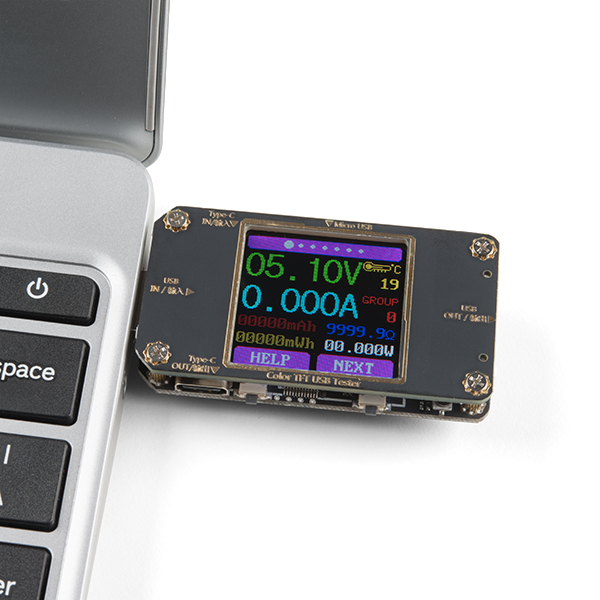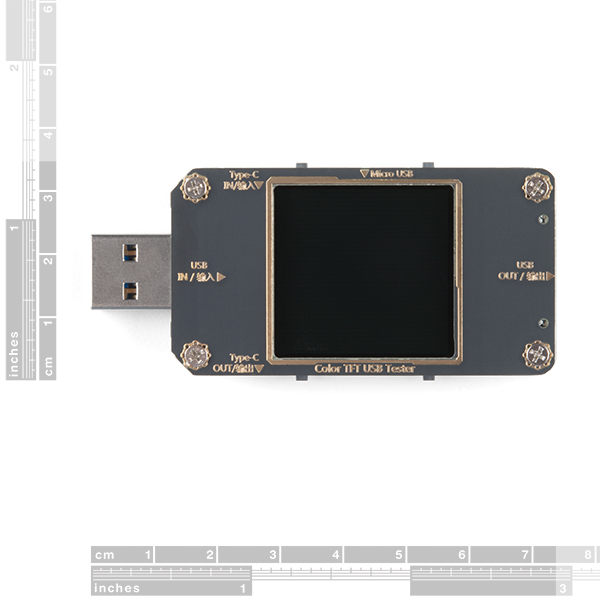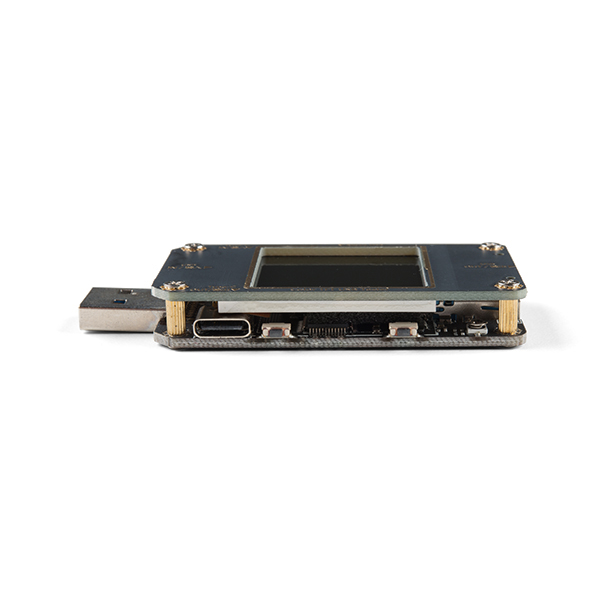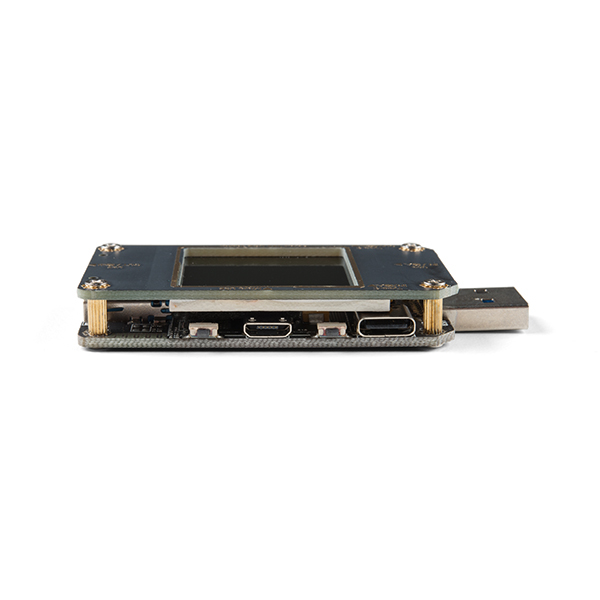This USB Power Meter is a versatile little tool that can provide voltage readings down to 0.01V and current to 0.001A, displayed on the built-in color TFT LCD, while your device is connected through it to a power source. You can also measure the capacity and power of battery packs/power banks as well as temperature and cable impedance!
In addition to the main numeric measurement interface, you can also toggle to voltage and current bar graph interfaces (because who doesn't like a good graph?), quick charge identification mode, wire group impedance measurement, and a simple settings screen. And with the recording option, you can easily record your data. Mmmmm data...
- Input voltage: 4.5-24V
- Input current: 0-3A
- Capacity measurement range: 0-99999mAh
- Energy measurement range: 0-99999mWh
- Load impedance measurement range: 1.5-9999.9Ω
- Temperature Measurement Range: -10°C-100°C / 0°F-200°F
- Voltage measurement resolution: 0.01V
- Current measurement resolution: 0.001A
- Voltage measurement accuracy: ±0.2%
- Current measurement accuracy: ±0.8%
- Recording range: 0-99 hours 59 minutes 59 seconds
- PD QC2.0, QC3.0/4.0, MTK
USB Power Meter (Color TFT LCD) Product Help and Resources
3 of 4 found this helpful:
Powering the USB Power Meter via USB type-C
If you notice your USB Power Meter is not turning on when connected to a USB Type-C power source that can deliver multiple voltages depending on what device is connected, simply plug in whichever device you want to measure the power consumption of and the USB Power Meter should turn on. The issue seems to stem from USB Type-C handshaking protocol to confirm the proper voltage for a device attached to a USB Type-C power supply. The USB Power Meter passes these connections through the USB C input to a device connected to one of the outputs so without a device connected to the output of the Power Meter, it does not know what voltage to request from the power supply and will not turn on.
Core Skill: Electrical Prototyping
If it requires power, you need to know how much, what all the pins do, and how to hook it up. You may need to reference datasheets, schematics, and know the ins and outs of electronics.
Skill Level: Competent - You will be required to reference a datasheet or schematic to know how to use a component. Your knowledge of a datasheet will only require basic features like power requirements, pinouts, or communications type. Also, you may need a power supply that?s greater than 12V or more than 1A worth of current.
See all skill levels
Comments
Looking for answers to technical questions?
We welcome your comments and suggestions below. However, if you are looking for solutions to technical questions please see our Technical Assistance page.
Customer Reviews
3.6 out of 5
Based on 7 ratings:
2 of 2 found this helpful:
Inexpensive way to measure current draw on USB devices
I bought this to verify the charging current on a USB device that has a design flaw where a lithium ion battery is charged at an very inappropriate rate on some of the units sold-depending upon where the battery in each particular unit was sourced. For simple USB voltage and current measurements it appears to work well. No convenient way to verify accuracy. The minuses: no manual so it is left to the user to figure out some of the other features. Also some of these default to Chinese for the user interface. Thanks to the Sparkfun community that pointed me to a youtube video explaining how to change the language setting. In a nutshell, as you are plugging it in to power hold the tiny button above and to the left of the screen. As it powers up a menu will appear. As long as you hold the button in the unit will slowly scroll through the 2 or 3 language choices. Here is a link to the video: https://www.youtube.com/watch?v=99qP7rXDOyU Please note that the unit shown in the video will look different from the one sold by Sparkfun. As soon as you get the unit into a language that you can read I recommend pressing the help button. The help screen is pretty basic but helpful. I would have given this 3 stars, however it comes in a very nice tin for storage. Like an Altoids tin but with a window.
Edit:
Exploring this device further it seems that most of the other functionality is pretty straightforward. It has some graphing functions that seem to work as expected, although you may need magnifying glasses to make sense of the graphs, they are pretty tiny. I am not sure if there is a way of getting the data out of the device, there is a microUSB IN that is not matched by a corresponding output.
Nice little USB meter
Does a great job of telling you what's going on with regards to power, highly recommend if you need to figure out what kind of power is being supplied or drawn from a USB port.
Cool little meter
I bought a couple to verify power brick capacities. They are doing that job well enough. I have no real need to measure the resistance of cables but maybe one day. The trends are pretty useless to me so far but add a gee-whiz factor. Between the manual and contextual help I have 80% of my questions answered. It does the job and has a fancy screen. If that isn't worth 4 stars, what is?
Very Handy With Lots of Features
It's the best product of this type I have seen. I haven't tried all the features, and probably never will. (I don't need to save data or make plots.) But, basic measurements are quick and easy. The variety of USB plug types is nice.
USB Power Meter
This product is an exceptionally useful tool for anyone building products that utilize a laptop to power a product. It paid for itself the first time we used it.
Doesn't work
Instructions referred to a "reset" button but this button is not identified on the user information on the web site. The unit does not respond to attempts to move through the modes. Terrible, terrible waste of my time.
Great while it lasted
I got one of these last year and it was great, for a while. One day it just stopped turning on. I still have it but it's basically a little brick with USB ports. It might be good for you but plan ahead for how you'll recycle it, because you'll probably do that not too long after getting it.










For those who would like to change the language setting of their USB power meter: If you hold the tiny little button that is on the top edge of the device, furthest to the left in while you are plugging it in to power it will bring up a menu that as long as you are holding in the button will toggle between Chinese and English. It will go from setting to setting with about a 1 second delay. Once you get it to a language that you understand you may want to press the help button for a brief introduction to what the 4 buttons do. Kind of sort of straightforward-ish. Still be nice to have a manual. Not sure why these types of things don't have a manual made by the designer these days... Might be a fun project for a small group of people to design a replacement to this to be designed and manufactured in the US... Maybe marketed by a company that sells devices like this to hobbyists.
Is there a datasheet or user's guide somewhere? I have so many questions. Is it solely USB-A to USB-A? Do the two USB-C ports mean it has support for that connector as well? Can it handle all of the different USB PD modes as well as the bidirectionality? Is it independently powered via the USB micro port or does it draw power from the measuring source? Is the micro port for data collection or another option for pass-through?
The supplier indicated it can handle PD QC2.0, QC3.0/4.0, and MTK protocols. Still working on getting an English manual.
It has USB A in + out, USB C in + out, and USB micro B in ports. The micro is another option for pass-through. Unfortunately, the only manual we could get for it at the moment is in Chinese! We've requested a translation and should hopefully have that before too long. On the bright side, the device itself has an English option (including help screens), and is pretty easy and intuitive to use. I will look into the USB PD modes and have an answer here shortly.
Hey i can supply You guys with English manual if You want to.
What are the logging capabilities? ,which measuments/ sample rate etc and can you acces them via usb? or?
Would love an open-source reprogrammable version of this with bluetooth and 5 UI buttons usual Up, Down, Left, Right, OK in the middle type deal....
Unfortunately, this is a resale product. However, there is a good project posted on Hackaday.
Is there a way to change the user interface from Chinese to English? I bought two units. One displayed English, but the other in Chinese.
What is the measurement frequency? Sample rate? How many samples can it remember on its flash?
Here's more information from another company on Amazon: https://www.amazon.com/Tester-Eversame-Voltmeter-Ammeter-Braided/dp/B07MGQZHGM/ref=asc_df_B07MGQZHGM/?tag=hyprod-20&linkCode=df0&hvadid=309777814505&hvpos=1o4&hvnetw=g&hvrand=1201375065019669462&hvpone=&hvptwo=&hvqmt=&hvdev=c&hvdvcmdl=&hvlocint=&hvlocphy=9021436&hvtargid=aud-801738734305:pla-637249909161&psc=1 Too bad this doesn't cover the full USB 3.0 PP spec, but I can understand why.
Ditto, ditto, ditto to all the previous comments.
This looks really useful!!! Please post a user guide.